Yawar Siddiqui
VertexRegen: Mesh Generation with Continuous Level of Detail
Aug 12, 2025Abstract:We introduce VertexRegen, a novel mesh generation framework that enables generation at a continuous level of detail. Existing autoregressive methods generate meshes in a partial-to-complete manner and thus intermediate steps of generation represent incomplete structures. VertexRegen takes inspiration from progressive meshes and reformulates the process as the reversal of edge collapse, i.e. vertex split, learned through a generative model. Experimental results demonstrate that VertexRegen produces meshes of comparable quality to state-of-the-art methods while uniquely offering anytime generation with the flexibility to halt at any step to yield valid meshes with varying levels of detail.
Human-in-the-Loop Local Corrections of 3D Scene Layouts via Infilling
Mar 14, 2025Abstract:We present a novel human-in-the-loop approach to estimate 3D scene layout that uses human feedback from an egocentric standpoint. We study this approach through introduction of a novel local correction task, where users identify local errors and prompt a model to automatically correct them. Building on SceneScript, a state-of-the-art framework for 3D scene layout estimation that leverages structured language, we propose a solution that structures this problem as "infilling", a task studied in natural language processing. We train a multi-task version of SceneScript that maintains performance on global predictions while significantly improving its local correction ability. We integrate this into a human-in-the-loop system, enabling a user to iteratively refine scene layout estimates via a low-friction "one-click fix'' workflow. Our system enables the final refined layout to diverge from the training distribution, allowing for more accurate modelling of complex layouts.
MeshArt: Generating Articulated Meshes with Structure-guided Transformers
Dec 16, 2024



Abstract:Articulated 3D object generation is fundamental for creating realistic, functional, and interactable virtual assets which are not simply static. We introduce MeshArt, a hierarchical transformer-based approach to generate articulated 3D meshes with clean, compact geometry, reminiscent of human-crafted 3D models. We approach articulated mesh generation in a part-by-part fashion across two stages. First, we generate a high-level articulation-aware object structure; then, based on this structural information, we synthesize each part's mesh faces. Key to our approach is modeling both articulation structures and part meshes as sequences of quantized triangle embeddings, leading to a unified hierarchical framework with transformers for autoregressive generation. Object part structures are first generated as their bounding primitives and articulation modes; a second transformer, guided by these articulation structures, then generates each part's mesh triangles. To ensure coherency among generated parts, we introduce structure-guided conditioning that also incorporates local part mesh connectivity. MeshArt shows significant improvements over state of the art, with 57.1% improvement in structure coverage and a 209-point improvement in mesh generation FID.
Meta 3D Gen
Jul 02, 2024



Abstract:We introduce Meta 3D Gen (3DGen), a new state-of-the-art, fast pipeline for text-to-3D asset generation. 3DGen offers 3D asset creation with high prompt fidelity and high-quality 3D shapes and textures in under a minute. It supports physically-based rendering (PBR), necessary for 3D asset relighting in real-world applications. Additionally, 3DGen supports generative retexturing of previously generated (or artist-created) 3D shapes using additional textual inputs provided by the user. 3DGen integrates key technical components, Meta 3D AssetGen and Meta 3D TextureGen, that we developed for text-to-3D and text-to-texture generation, respectively. By combining their strengths, 3DGen represents 3D objects simultaneously in three ways: in view space, in volumetric space, and in UV (or texture) space. The integration of these two techniques achieves a win rate of 68% with respect to the single-stage model. We compare 3DGen to numerous industry baselines, and show that it outperforms them in terms of prompt fidelity and visual quality for complex textual prompts, while being significantly faster.
Meta 3D AssetGen: Text-to-Mesh Generation with High-Quality Geometry, Texture, and PBR Materials
Jul 02, 2024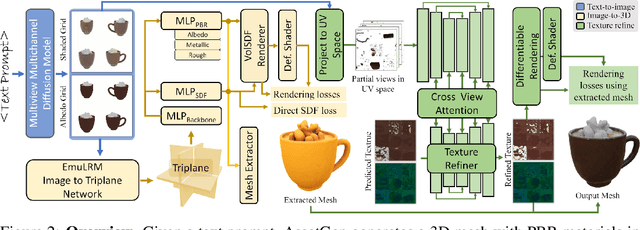

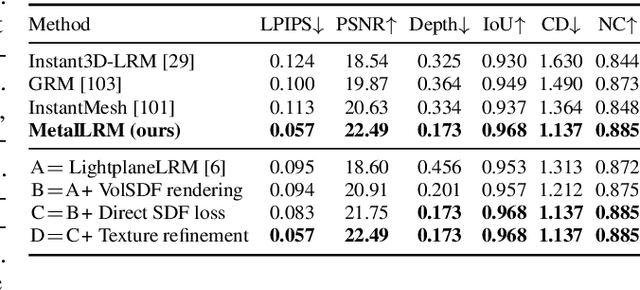
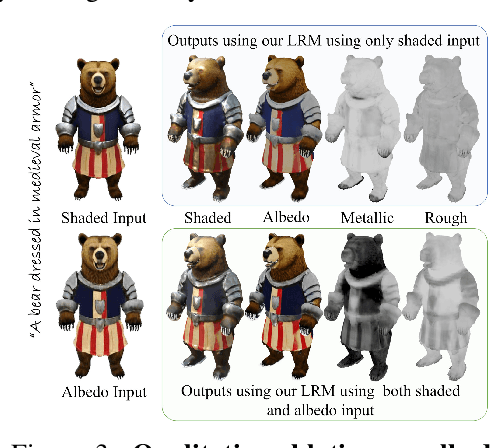
Abstract:We present Meta 3D AssetGen (AssetGen), a significant advancement in text-to-3D generation which produces faithful, high-quality meshes with texture and material control. Compared to works that bake shading in the 3D object's appearance, AssetGen outputs physically-based rendering (PBR) materials, supporting realistic relighting. AssetGen generates first several views of the object with factored shaded and albedo appearance channels, and then reconstructs colours, metalness and roughness in 3D, using a deferred shading loss for efficient supervision. It also uses a sign-distance function to represent 3D shape more reliably and introduces a corresponding loss for direct shape supervision. This is implemented using fused kernels for high memory efficiency. After mesh extraction, a texture refinement transformer operating in UV space significantly improves sharpness and details. AssetGen achieves 17% improvement in Chamfer Distance and 40% in LPIPS over the best concurrent work for few-view reconstruction, and a human preference of 72% over the best industry competitors of comparable speed, including those that support PBR. Project page with generated assets: https://assetgen.github.io
PolyDiff: Generating 3D Polygonal Meshes with Diffusion Models
Dec 18, 2023Abstract:We introduce PolyDiff, the first diffusion-based approach capable of directly generating realistic and diverse 3D polygonal meshes. In contrast to methods that use alternate 3D shape representations (e.g. implicit representations), our approach is a discrete denoising diffusion probabilistic model that operates natively on the polygonal mesh data structure. This enables learning of both the geometric properties of vertices and the topological characteristics of faces. Specifically, we treat meshes as quantized triangle soups, progressively corrupted with categorical noise in the forward diffusion phase. In the reverse diffusion phase, a transformer-based denoising network is trained to revert the noising process, restoring the original mesh structure. At inference, new meshes can be generated by applying this denoising network iteratively, starting with a completely noisy triangle soup. Consequently, our model is capable of producing high-quality 3D polygonal meshes, ready for integration into downstream 3D workflows. Our extensive experimental analysis shows that PolyDiff achieves a significant advantage (avg. FID and JSD improvement of 18.2 and 5.8 respectively) over current state-of-the-art methods.
MeshGPT: Generating Triangle Meshes with Decoder-Only Transformers
Nov 27, 2023



Abstract:We introduce MeshGPT, a new approach for generating triangle meshes that reflects the compactness typical of artist-created meshes, in contrast to dense triangle meshes extracted by iso-surfacing methods from neural fields. Inspired by recent advances in powerful large language models, we adopt a sequence-based approach to autoregressively generate triangle meshes as sequences of triangles. We first learn a vocabulary of latent quantized embeddings, using graph convolutions, which inform these embeddings of the local mesh geometry and topology. These embeddings are sequenced and decoded into triangles by a decoder, ensuring that they can effectively reconstruct the mesh. A transformer is then trained on this learned vocabulary to predict the index of the next embedding given previous embeddings. Once trained, our model can be autoregressively sampled to generate new triangle meshes, directly generating compact meshes with sharp edges, more closely imitating the efficient triangulation patterns of human-crafted meshes. MeshGPT demonstrates a notable improvement over state of the art mesh generation methods, with a 9% increase in shape coverage and a 30-point enhancement in FID scores across various categories.
Text2Tex: Text-driven Texture Synthesis via Diffusion Models
Mar 20, 2023Abstract:We present Text2Tex, a novel method for generating high-quality textures for 3D meshes from the given text prompts. Our method incorporates inpainting into a pre-trained depth-aware image diffusion model to progressively synthesize high resolution partial textures from multiple viewpoints. To avoid accumulating inconsistent and stretched artifacts across views, we dynamically segment the rendered view into a generation mask, which represents the generation status of each visible texel. This partitioned view representation guides the depth-aware inpainting model to generate and update partial textures for the corresponding regions. Furthermore, we propose an automatic view sequence generation scheme to determine the next best view for updating the partial texture. Extensive experiments demonstrate that our method significantly outperforms the existing text-driven approaches and GAN-based methods.
Panoptic Lifting for 3D Scene Understanding with Neural Fields
Dec 19, 2022



Abstract:We propose Panoptic Lifting, a novel approach for learning panoptic 3D volumetric representations from images of in-the-wild scenes. Once trained, our model can render color images together with 3D-consistent panoptic segmentation from novel viewpoints. Unlike existing approaches which use 3D input directly or indirectly, our method requires only machine-generated 2D panoptic segmentation masks inferred from a pre-trained network. Our core contribution is a panoptic lifting scheme based on a neural field representation that generates a unified and multi-view consistent, 3D panoptic representation of the scene. To account for inconsistencies of 2D instance identifiers across views, we solve a linear assignment with a cost based on the model's current predictions and the machine-generated segmentation masks, thus enabling us to lift 2D instances to 3D in a consistent way. We further propose and ablate contributions that make our method more robust to noisy, machine-generated labels, including test-time augmentations for confidence estimates, segment consistency loss, bounded segmentation fields, and gradient stopping. Experimental results validate our approach on the challenging Hypersim, Replica, and ScanNet datasets, improving by 8.4, 13.8, and 10.6% in scene-level PQ over state of the art.
DiffRF: Rendering-Guided 3D Radiance Field Diffusion
Dec 02, 2022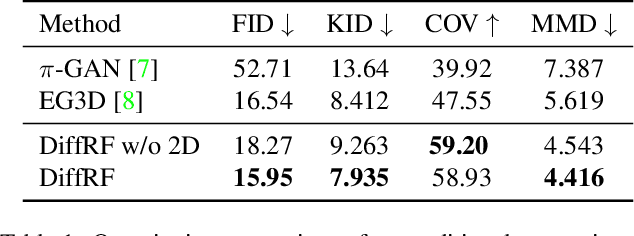

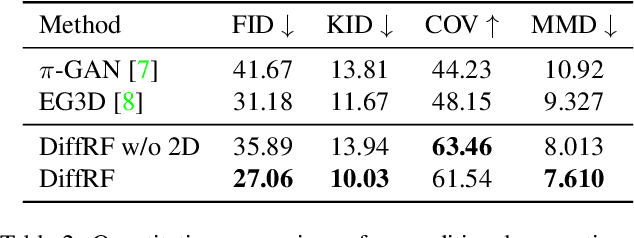
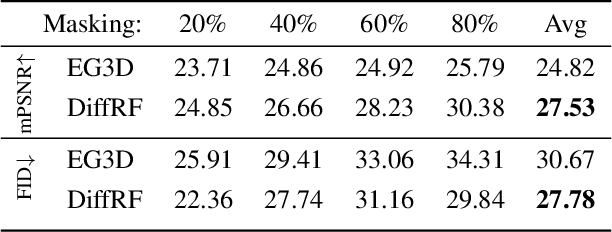
Abstract:We introduce DiffRF, a novel approach for 3D radiance field synthesis based on denoising diffusion probabilistic models. While existing diffusion-based methods operate on images, latent codes, or point cloud data, we are the first to directly generate volumetric radiance fields. To this end, we propose a 3D denoising model which directly operates on an explicit voxel grid representation. However, as radiance fields generated from a set of posed images can be ambiguous and contain artifacts, obtaining ground truth radiance field samples is non-trivial. We address this challenge by pairing the denoising formulation with a rendering loss, enabling our model to learn a deviated prior that favours good image quality instead of trying to replicate fitting errors like floating artifacts. In contrast to 2D-diffusion models, our model learns multi-view consistent priors, enabling free-view synthesis and accurate shape generation. Compared to 3D GANs, our diffusion-based approach naturally enables conditional generation such as masked completion or single-view 3D synthesis at inference time.
 Add to Chrome
Add to Chrome Add to Firefox
Add to Firefox Add to Edge
Add to Edge